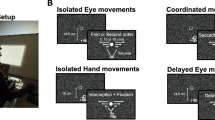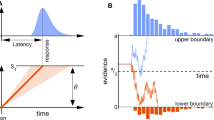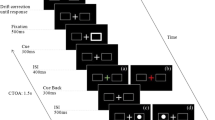Abstract
We previously showed that saccades tend to overshoot briefly flashed targets that were manually displaced in the dark (Ren et al. 2006). However it was not clear if the overshoot originated from a sensory error in measuring hand displacement or from a premotor error in saccade programming, because gaze and hand position started at the same central position. Here, we tested between these hypotheses by dissociating the initial eye and hand position. Five hand/target positions (center, far, near, right, left) on a frontally-placed horizontal surface were used in four paradigms: Center or Peripheral Eye-hand Association (CA or PA, both gaze and right hand started from the center or a same peripheral location) and Hand or Eye Dissociation (HD or ED, hand or gaze started from one of three non-target peripheral locations). Subjects never received any visual feedback about the final target location and the subjects’ hand displacement. In the CA paradigm, subjects showed the same overshoot that we showed previously. However, changing both initial eye and hand positions relative to the final target (PA) affected the pattern, significantly altering the directions of overshoots. Changing only the initial position of hand (HD) did not have this effect, whereas changing only initial eye position (ED) had the same effect as the PA condition (CA ≈ HD, PA ≈ ED). Furthermore, multiple regression analysis showed that the direction of the ideal saccade contributed significantly to the endpoint direction error, not the direction of the hand path. These results suggest that these errors do not primarily arise from misestimates of the hand trajectory, but rather from a process of comparing the initial eye position and the limb proprioceptive signal during saccade programming.





Similar content being viewed by others
References
Abrams RA, Meyer DE, Kornblum S (1990) Eye-hand coordination: oculomotor control in rapid aimed limb movements. J Exp Psychol Hum Percept Perform 16(2):248–267
Andersen RA, Buneo CA (2002) Intentional maps in posterior parietal cortex. Annu Rev Neurosci 25:189–220
Batista AP, Buneo CA, Snyder LH, Andersen RA (1999) Reach plans in eye-centered coordinates. Science 285(5425):257–260
Buneo CA, Jarvis MR, Batista AP, Andersen RA (2002) Direct visuomotor transformations for reaching. Nature 416(6881):632–636
Clark FJ (1992) How accurately can we perceive the positions of our limbs? Behav Brain Sci 15:725–726
Clark FJ, Larwood KJ, Davis ME, Deffenbacher KA (1995) A metric for assessing acuity in positioning joints and limbs. Exp Brain Res 107:73–79
Colby CL, Duhamel JR, Goldberg ME (1995) Oculocentric spatial representation in parietal cortex. Cereb Cortex 5:470–481
Deubel H (1987) Adaptivity of gain and direction in oblique saccades. In: O’Regan J, Levy-Schoen A (eds) Eye movements: from physiology to cognition. Elsevier, Amsterdam, pp 181–190
Dickinson AR, Calton JL, Snyder LH (2003) Nonspatial saccade-specific activation in area LIP of monkey parietal cortex. J Neurophysiol 90(4):2460–2464
Duhamel JR, Colby CL, Goldberg ME (1992) The updating of the representation of visual space in parietal cortex by intended eye movements. Science 255(5040):90–92
Flanagan JR, Johansson RS (2003) Action plans used in action observation. Nature 424(6950):769–771
Heide W, Binkofski F, Seitz RJ, Posse S, Nitschke MF, Freund HJ, Kompf D (2001) Activation of frontoparietal cortices during memorized triple-step sequences of saccadic eye movements: an fMRI study. Eur J Neurosci 13(6):1177–1189
Helsen WF, Elliott D, Starkes JL, Ricker KL (2000) Coupling of eye, finger, elbow, and shoulder movements during manual aiming. J Mot Behav 32(3):241–248
Henriques DYP, Crawford JD (2001) Testing the three-dimensional reference frame transformation for express and memory-guided saccades. Neurocomputing 38–40:1267–1280
Henriques DY, Klier EM, Smith MA, Lowy D, Crawford JD (1998) Gaze-centered remapping of remembered visual space in an open-loop pointing task. J Neurosci 18(4):1583–1594
Hogan N (1985) The mechanics of multi-joint posture and movement control. Biol Cybern 52:315–331
Johansson RS, Westling G, Backstrom A, Flanagan JR (2001) Eye-hand coordination in object manipulation. J Neurosci 21(17):6917–6932
Medendorp WP, Goltz HC, Vilis T, Crawford JD (2003) Gaze-centered updating of visual space in human parietal cortex. J Neurosci 23(15):6209–6214
Nakamura K, Colby CL (2002) Updating of the visual representation in monkey striate and extrastriate cortex during saccades. Proc Natl Acad Sci USA 99(6):4026–4031
Nanayakkara T, Shadmehr R (2003) Saccade adaptation in response to altered arm dynamics. J Neurophysiol 90(6):4016–4021
Neggers SF, Bekkering H (2000) Ocular gaze is anchored to the target of an ongoing pointing movement. J Neurophysiol 83(2):639–651
Neggers SF, Bekkering H (2001) Gaze anchoring to a pointing target is present during the entire pointing movement and is driven by a non-visual signal. J Neurophysiol 86(2):961–970
Ren L, Khan AZ, Blohm G, Henriques DYP, Sergio LE, Crawford JD (2006) Proprioceptive guidance of saccades in eye-hand coordination. J Neurophysiol 96:1464–1477
Sabes PN, Jordan MI, Wolpert DM (1998) The role of inertial sensitivity in motor planning. J Neurosci 18(15):5948–5957
Scheidt RA, Conditt MA, Secco EL, Mussa-Ivaldi FA (2005) Interaction of visual and proprioceptive feedback during adaptation of human reaching movements. J Neurophysiol 93(6):3200–3213
Scott SH, Loeb GE (1994) The computation of position sense from spindles in mono- and multiarticular muscles. J Neurosci 14:7529–7540
Snyder LH, Batista AP, Andersen RA (1997) Coding of intention in the posterior parietal cortex. Nature 386(6621):167–170
Soechtinge JF, Buneo CA, Herrmann U, Flanders M (1995) Moving effortlessly in three dimensions: does Donders’ law apply to arm movement? J Neurosci 15(9):6271–6280
Tweed D, Cadera W, Vilis T (1990) Computing three-dimensional eye position quaternions and eye velocity from search coil signals. Vision Res 30(1):97–110
Van Beers RJ, Sittig AC, Denier van der Gon JJ (1998) The precision of proprioceptive position sense. Exp Brain Res 122:367–377
Van Opstal AJ, van Gisbergen JA (1990) Role of monkey superior colliculus in saccade averaging. Exp Brain Res 79:143–149
Vercher JL, Quaccia D, Gauthier GM (1995) Oculo-manual coordination control: respective role of visual and non-visual information in ocular tracking of self-moved targets. Exp Brain Res 103:311–322
White JM, Sparks DL, Stanford TR (1994) Saccades to remembered target locations: an analysis of systematic and variable errors. Vision Res 34(1):79–92
Acknowledgments
We thank S. Sun and H. Wang for technical support. This work was supported by the Canadian Institutes of Health Research (CIHR). LR was supported by Ontario Graduate Scholarship, GB was supported by a Marie Curie International fellowship within the 6th European Community Framework Program and CIHR (Canada), and JDC holds a Canada Research Chair.
Author information
Authors and Affiliations
Corresponding author
Rights and permissions
About this article
Cite this article
Ren, L., Blohm, G. & Crawford, J.D. Comparing limb proprioception and oculomotor signals during hand-guided saccades. Exp Brain Res 182, 189–198 (2007). https://doi.org/10.1007/s00221-007-0981-5
Received:
Accepted:
Published:
Issue Date:
DOI: https://doi.org/10.1007/s00221-007-0981-5




